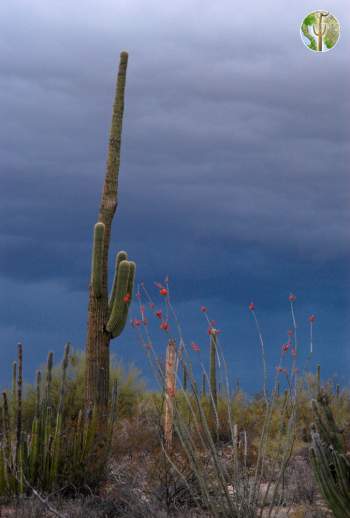About Sonora
 Sonora is an amazingly biologically diverse state! The southeast has genuine tropical forest -- some of the northernmost tropical forest in the world. By contrast far northwest Sonora has vast sand dunes and seemingly endless plains of creosote in the western Sonoran Desert, often receiving only a few inches of rain annually, if that. There are bits of Chihuahuan Desert and even full-fledged plains grassland in the northeast. The eastern flank of the state is mountainous, transitioning from Sky Islands in the north to the Sierra Madre Occidental as you move southward. Some of the southernmost Rocky Mountain influences mix in northeastern mountains with Madrean species that dominate the Sierra Madre.
Sonora is an amazingly biologically diverse state! The southeast has genuine tropical forest -- some of the northernmost tropical forest in the world. By contrast far northwest Sonora has vast sand dunes and seemingly endless plains of creosote in the western Sonoran Desert, often receiving only a few inches of rain annually, if that. There are bits of Chihuahuan Desert and even full-fledged plains grassland in the northeast. The eastern flank of the state is mountainous, transitioning from Sky Islands in the north to the Sierra Madre Occidental as you move southward. Some of the southernmost Rocky Mountain influences mix in northeastern mountains with Madrean species that dominate the Sierra Madre.
Much of the foothills of the Sierra Madre and other central and southern areas of Sonora are dominated by Sinaloan Thorn-scrub. Sonora also has a vast and beautiful coastline of which many parts are amazingly wild for this modern age, although this may be changing.
There are mangrove swamps and coastal river plains that are incredibly productive and important migratory resources for birds. Coastal river plains in Sonora have been converted to some of the most productive agricultural areas in the world, but are no longer able to support the vast assemblages of wildlife that historically inhabited them.
Sonora has mangrove estuaries almost as far north as Puerto Libertad. Shockingly there is evidence that crocodiles inhabited the gulf of California all the way to the Colorado river delta into the 1900's. The coastline and sea life of the Gulf of California are also incredibly diverse. Cousteau described the Gulf as "the world’s aquarium". The gulf's waters are experiencing over-fishing, destructive shrimping, and numerous other problems. Another issue for the Gulf's ecosystem is the lack of fresh water, sediment, and nutrients flowing into the northern delta area from the Colorado River, seriously impacting the whole food chain and web of life in the Gulf. A great group out of Puerto Piñasco (CEDO) works to protect the Gulf of California and its wildlife.
Last, but certainly not least (as it covers about half of the state), is the Sonoran Desert, which has several very different subdivisions in Sonora--Central Gulf Coast, Lower Colorado River Valley, Arizona Uplands, and Plains of Sonora. It is considered the wettest desert in the world. The Sonoran Desert is a lush, diverse, and beautiful desert and has a knack for capturing the hearts of most who spend time with it. Much of the Sonoran Desert's special character is due to it receiving biannual rainfall, as well as occasional tropical storm moisture in the late summer and fall.
Sonora, although changing fast, still has a wild west feel in many or most parts. A decent amount of the state is still accessible only by dirt road, or less. It is lightly inhabited compared to most of Mexico.
The people of Sonora are very friendly and hospitable. In recent years many people with less resources have migrated north, many of whom get stuck in border towns such as Nogales working in maquiladores or in the economic corridors of Route 15 and Route 2. The population and economy of Sonora has been growing quickly in recent years.
